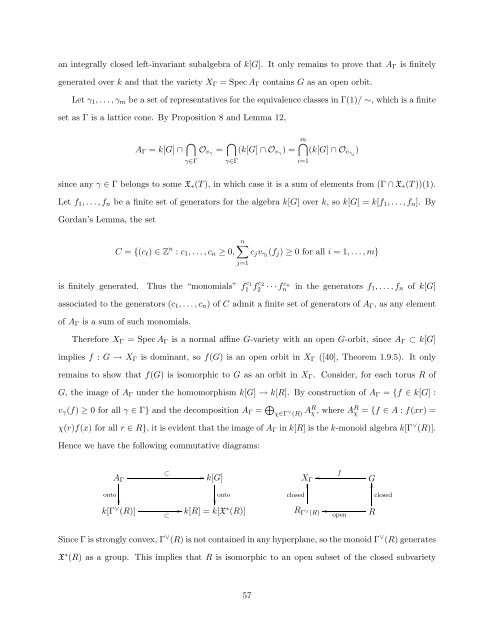Equivariant Embeddings of Algebraic Groups
Equivariant Embeddings of Algebraic Groups
Equivariant Embeddings of Algebraic Groups
Create successful ePaper yourself
Turn your PDF publications into a flip-book with our unique Google optimized e-Paper software.
an integrally closed left-invariant subalgebra <strong>of</strong> k[G]. It only remains to prove that A Γ is finitely<br />
generated over k and that the variety X Γ = Spec A Γ contains G as an open orbit.<br />
Let γ 1 , . . . , γ m be a set <strong>of</strong> representatives for the equivalence classes in Γ(1)/ ∼, which is a finite<br />
set as Γ is a lattice cone. By Proposition 8 and Lemma 12,<br />
A Γ = k[G] ∩ ⋂ γ∈Γ<br />
O vγ = ⋂ γ∈Γ(k[G] ∩ O vγ ) =<br />
m⋂<br />
(k[G] ∩ O vγi )<br />
since any γ ∈ Γ belongs to some X ∗ (T ), in which case it is a sum <strong>of</strong> elements from (Γ ∩ X ∗ (T ))(1).<br />
Let f 1 , . . . , f n be a finite set <strong>of</strong> generators for the algebra k[G] over k, so k[G] = k[f 1 , . . . , f n ]. By<br />
Gordan’s Lemma, the set<br />
C = {(c l ) ∈ Z n : c 1 , . . . , c n ≥ 0,<br />
i=1<br />
n∑<br />
c j v γi (f j ) ≥ 0 for all i = 1, . . . , m}<br />
j=1<br />
is finitely generated. Thus the “monomials” f c 1<br />
1 f c 2<br />
2 · · · f n<br />
cn<br />
in the generators f 1 , . . . , f n <strong>of</strong> k[G]<br />
associated to the generators (c 1 , . . . , c n ) <strong>of</strong> C admit a finite set <strong>of</strong> generators <strong>of</strong> A Γ , as any element<br />
<strong>of</strong> A Γ is a sum <strong>of</strong> such monomials.<br />
Therefore X Γ = Spec A Γ is a normal affine G-variety with an open G-orbit, since A Γ ⊂ k[G]<br />
implies f : G → X Γ is dominant, so f(G) is an open orbit in X Γ ([40], Theorem 1.9.5). It only<br />
remains to show that f(G) is isomorphic to G as an orbit in X Γ . Consider, for each torus R <strong>of</strong><br />
G, the image <strong>of</strong> A Γ under the homomorphism k[G] → k[R]. By construction <strong>of</strong> A Γ = {f ∈ k[G] :<br />
v γ (f) ≥ 0 for all γ ∈ Γ} and the decomposition A Γ = ⊕ χ∈Γ ∨ (R) AR χ , where A R χ = {f ∈ A : f(xr) =<br />
χ(r)f(x) for all r ∈ R}, it is evident that the image <strong>of</strong> A Γ in k[R] is the k-monoid algebra k[Γ ∨ (R)].<br />
Hence we have the following commutative diagrams:<br />
⊂<br />
A Γ<br />
k[G]<br />
X Γ<br />
f<br />
G<br />
onto<br />
<br />
k[Γ ∨ (R)]<br />
⊂<br />
onto<br />
k[R] = k[X ∗ (R)]<br />
closed<br />
R Γ ∨ (R)<br />
open<br />
R<br />
closed<br />
Since Γ is strongly convex, Γ ∨ (R) is not contained in any hyperplane, so the monoid Γ ∨ (R) generates<br />
X ∗ (R) as a group. This implies that R is isomorphic to an open subset <strong>of</strong> the closed subvariety<br />
57
















